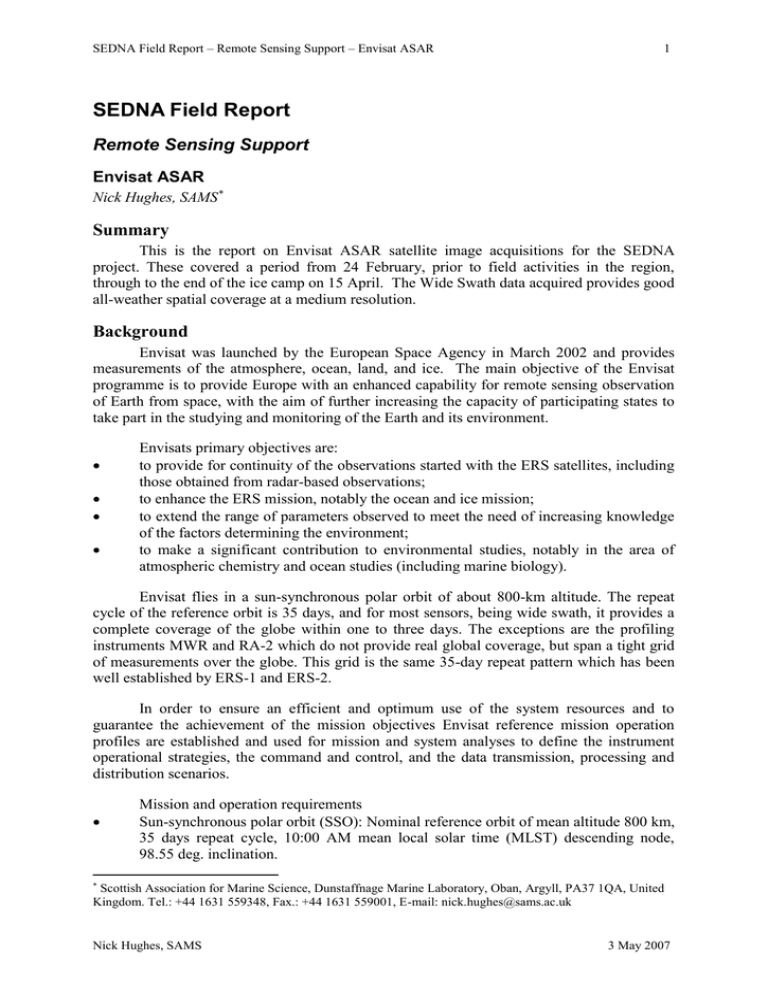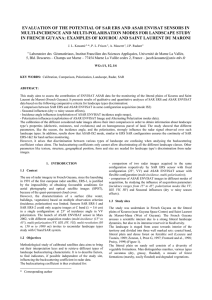SEDNA Field Report Remote Sensing Support Summary Envisat ASAR
advertisement

SEDNA Field Report – Remote Sensing Support – Envisat ASAR 1 SEDNA Field Report Remote Sensing Support Envisat ASAR Nick Hughes, SAMS* Summary This is the report on Envisat ASAR satellite image acquisitions for the SEDNA project. These covered a period from 24 February, prior to field activities in the region, through to the end of the ice camp on 15 April. The Wide Swath data acquired provides good all-weather spatial coverage at a medium resolution. Background Envisat was launched by the European Space Agency in March 2002 and provides measurements of the atmosphere, ocean, land, and ice. The main objective of the Envisat programme is to provide Europe with an enhanced capability for remote sensing observation of Earth from space, with the aim of further increasing the capacity of participating states to take part in the studying and monitoring of the Earth and its environment. Envisats primary objectives are: to provide for continuity of the observations started with the ERS satellites, including those obtained from radar-based observations; to enhance the ERS mission, notably the ocean and ice mission; to extend the range of parameters observed to meet the need of increasing knowledge of the factors determining the environment; to make a significant contribution to environmental studies, notably in the area of atmospheric chemistry and ocean studies (including marine biology). Envisat flies in a sun-synchronous polar orbit of about 800-km altitude. The repeat cycle of the reference orbit is 35 days, and for most sensors, being wide swath, it provides a complete coverage of the globe within one to three days. The exceptions are the profiling instruments MWR and RA-2 which do not provide real global coverage, but span a tight grid of measurements over the globe. This grid is the same 35-day repeat pattern which has been well established by ERS-1 and ERS-2. In order to ensure an efficient and optimum use of the system resources and to guarantee the achievement of the mission objectives Envisat reference mission operation profiles are established and used for mission and system analyses to define the instrument operational strategies, the command and control, and the data transmission, processing and distribution scenarios. Mission and operation requirements Sun-synchronous polar orbit (SSO): Nominal reference orbit of mean altitude 800 km, 35 days repeat cycle, 10:00 AM mean local solar time (MLST) descending node, 98.55 deg. inclination. * Scottish Association for Marine Science, Dunstaffnage Marine Laboratory, Oban, Argyll, PA37 1QA, United Kingdom. Tel.: +44 1631 559348, Fax.: +44 1631 559001, E-mail: nick.hughes@sams.ac.uk Nick Hughes, SAMS 3 May 2007 SEDNA Field Report – Remote Sensing Support – Envisat ASAR 2 The orbit is controlled to a maximum deviation of +/- 1 km from ground track and +/5 minutes on the equator crossing MLST. Recording of payload data over each orbit for low bit rate (4.6 Mps) on tape recorders or solid state recorder (SSR). High rate data (ASAR and MERIS) to be accessible by direct telemetry or recording on SSR. A number of scenes in medium resolution (150 metre) Wide Swath mode were ordered for the APLIS ice camp to coincide with the visit by the submarine HMS Tireless and to cover the activities of the SEDNA fieldwork. Wide Swath or WSM mode provides scenes covering 406 km across-track. Processing Envisat ASAR wide swath scenes were ordered from ESA in January 2007 using the EOLI SA software tool (http://eoli.esa.int/geteolisa/index.html). This provides a means of visually ensuring the correct area coverage is chosen and sends the necessary ordering parameters (orbit, time, type of product, etc.) to the ESA order desk. The requests of all the users are then evaluated and tasking of the satellite takes place according to the priority given to particular users. Data is then delivered on CD- ROM or DVD after processing by various production facilities, or can be downloaded directly from the ESA Rolling Archive. Frames were processed with scripts using the Basic ERS & Envisat (A)ATSR and Meris Toolbox (BEAM). This is freely available through http://www.brockmannconsult.de/beam/ and consists of a desktop application called VISAT and a number of command line tools written in open source Java code. BEAM converts the raw ESA data format into a GeoTIFF image file. This format is an interchange format for geo-referenced raster imagery based on the common Tag Image File Format (TIFF). Further information can be found at http://remotesensing.org/geotiff/geotiff.html. GeoTIFF format was then used for all further image processing and archiving. The images were reprojected to provide a consistent coverage. The projection used for SEDNA Envisat ASAR images is Polar Stereographic with a central longitude at 145°W and latitude of true scale at 90°N on the WGS84 datum. Resolution was increased to 100 metres, from the 150 metres maximum acquired by Envisat ASAR in Wide Swath mode, by cubic convolution interpolation to aid comparison with the MODIS images also acquired for SEDNA. The gdal_translate utility provided as part of the Geospatial Data Abstraction Library (GDAL) (http://www.gdal.org/) was used to apply data compression to the GeoTIFF image. GDAL is supplied in the FWTools open source GIS binary kit (http://fwtools.maptools.org/) which also includes other free applications including OpenEV and the PROJ.4 cartographic projections library. Nick Hughes, SAMS 3 May 2007 SEDNA Field Report – Remote Sensing Support – Envisat ASAR 3 Image Assessment A list of the images acquired is shown in the Appendix. Mosaics of the images delivered so far have been produced and are shown below. 24 February 2007 Two sets of images, one for the morning and one for the evening, were requested. Only the evening images, at around 20:09 UTC, were acquired due to a problem with the Artemis satellite which is used as a communications relay. The orbit covered the eastern part of the SEDNA field area and shows the transition from the first year ice through to large multi-year floes. Gaps between frames exist due to insufficient overlap being requested at the time of ordering. The amount of overlap required seems to vary according to which processing centre deals with the order. The missing data can be recovered as the data from the orbit segment is held in the ESA archive. 5 March 2007 Data from a morning orbit, at 06:54 UTC, and an evening orbit, at 20:27 UTC, were acquired. These provide good coverage of the SEDNA field area with overlap in the central region of interest. This set of images also suffers from gaps between frames. Nick Hughes, SAMS 3 May 2007 SEDNA Field Report – Remote Sensing Support – Envisat ASAR 4 20 March 2007 The next set of available images is from 20 March. Images were also acquired on 10 March but at the time of writing had yet to be delivered. The morning orbit occurred at 07:22 UTC and the evening orbit at 20:55 UTC. The images cover the central and western part of the SEDNA field area and occur during the time the submarine HMS Tireless was in the area conducting under-ice surveys. Image frames from these orbits are continuous with no gaps. 22 March 2007 Images from the 22 March cover the eastern and western sides of the SEDNA filed area and overlap in the central region to the north. The morning orbit was at 06:20 UTC and the evening orbit at 21:32 UTC. Nick Hughes, SAMS 3 May 2007 SEDNA Field Report – Remote Sensing Support – Envisat ASAR 5 24 March 2007 The images from 24 March were acquired at 06:56 UTC and 20:30 UTC. The central SEDNA field area is covered with a good overlap between the two sets of images. 27 March 2007 Images from the 27 March have a similar coverage to those from 24 March with good overlap in the central area around the position of the APLIS ice camp. The morning images were acquired at 07:02 UTC and the evening images at 20:35 UTC. Further images were acquired, as listed in the Appendix. Delivery of these is ongoing and will be reported on in a later report. Future Work Once delivery of images is complete and any gaps in coverage recovered the images will be compared with MODIS images of the area and other SAR images obtained from Radarsat for the project. Various methods for classifying SAR images for sea ice will be evaluated to see if, in conjunction with data from other sensors and in particular MODIS, improvements can be made. Acknowledgements The Envisat ASAR images were acquired as part of Professor Peter Wadham’s ESA Envisat Announcement of Opportunity project #208 ‘The Use of ASAR, AATSR and Altimeter Data Products for the study of Sea Ice Response to Climatic Change’. Nick Hughes, SAMS 3 May 2007 SEDNA Field Report – Remote Sensing Support – Envisat ASAR 6 Appendix - Images Acquired Date 24 February 2007 24 February 2007 5 March 2007 5 March 2007 10 March 2007 20 March 2007 20 March 2007 22 March 2007 22 March 2007 24 March 2007 24 March 2007 27 March 2007 27 March 2007 29 March 2007 29 March 2007 31 March 2007 31 March 2007 3 April 2007 3 April 2007 6 April 2007 6 April 2007 9 April 2007 9 April 2007 12 April 2007 12 April 2007 14 April 2007 Nick Hughes, SAMS Julian Day Start Time UTC 06:36:07 20:06:56 06:53:27 20:24:07 21:07:06 07:22:10 20:52:44 06:18:56 21:30:05 06:56:17 20:26:57 07:02:03 20:32:40 05:58:47 21:09:56 06:36:09 20:06:53 06:41:52 20:12:35 06:47:38 20:18:20 06:53:23 20:24:04 06:59:09 20:29:48 21:07:05 Stop Time UTC 06:41:03 20:12:26 06:58:15 20:29:41 21:12:47 07:26:42 20:58:24 06:23:58 21:35:46 07:01:04 20:32:31 07:06:47 20:38:15 06:03:56 21:15:37 06:41:04 20:12:23 06:46:45 20:18:07 06:52:29 20:23:53 06:58:11 20:29:38 07:03:55 20:35:24 21:12:46 Orbit Track Pass 26069 26077 26198 26206 26278 26413 26421 26441 26450 26470 26478 26513 26521 26541 26550 26570 26578 26613 26621 26656 26664 26699 26707 26742 26750 26779 464 472 92 100 172 307 315 335 344 364 372 407 415 435 444 464 472 6 14 49 57 92 100 135 143 172 A D A D A A D A D A D A D A D A D A D A D A D A D D Quality Not acquired 3 ra 2 3 3 ra 5 ra 4 ra 4 ra 2 ra 5 ra 2 ra 3 ra ra ra Not acquired 3 May 2007


